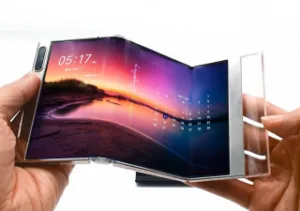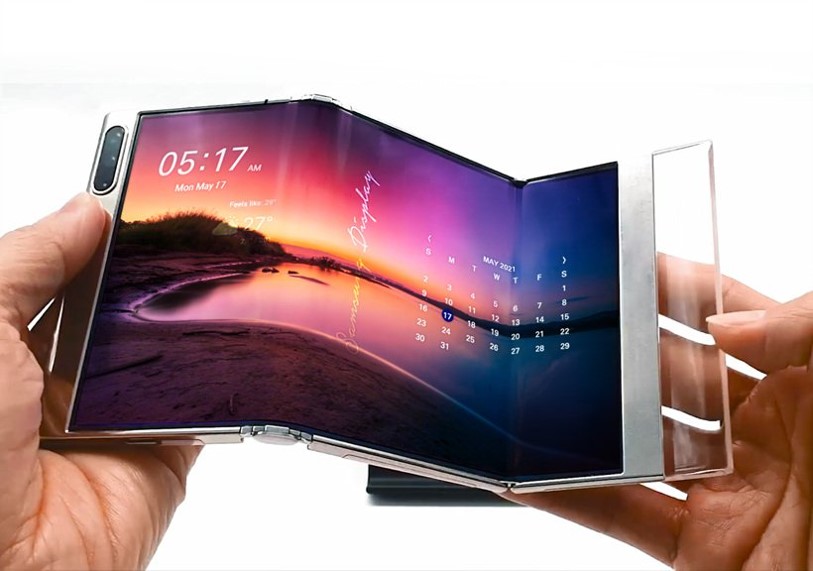An exuberant display industry showcased their next generation display technologies at Virtual DisplayWeek 2021 during May 17 to 21. The display industry is continuing along the path of innovations by bringing in new technologies, materials, and processes. The outlook for display industry revenue has never been better.

Unprecedented demand due to work from home and learning from home combined with supply constraint and panel price increases have resulted in record revenue expectations in 2021. That may have led SID to record >10,000 attendees for DisplayWeek conference this year.
LCD is reinventing itself with MiniLED and Quantum Dot, while OLED is evolving with better performance and new form factors. MicroLED is emerging as a next generation display product while Quantum Dot is enabling emissive displays such as QD OLED, QD MicroLED and NanoLED.
LCD: Reinventing with MiniLEDs
According to Ross Young’s DSCC Business Conference keynote presentation the FPD market before COVID was not pretty with declining revenue, declining prices, declining margins, companies exiting LCD-making, capex falling and little interest from Investors. Markets were also stagnant on a unit basis. Total industry fab utilization rates were on the decline, falling below 85% in Q4’19.
COVID-19 impacted display market with supply falling and demand rising. With units and prices rising, every major large display application is expected to grow at double-digit rates with TV revenues up over 50% on sharp panel price increases. According to DSCC, total display revenue grew 6% in 2020 and 2021 FPD revenue is expected to rise 29% to a record $152 billion. As the presentation pointed out, the best opportunity for growth in revenues is by minimizing over-investment and keeping supply tight while boosting display performance offering better value to end users with opportunities in OLEDs, MiniLEDs and microLEDs. MiniLED can boost LCD performance to OLED levels. A wide variety of MiniLED implementations are already available for TV, monitor and notebooks. DSCC expects MiniLED revenues to overtake OLEDs in TVs, monitors, notebooks and tablets. MiniLEDs are also a great opportunity for LCD suppliers to increase display performance, revenue and earnings.
BOE showcased its 75-inch 8K MiniLED product with >5,000 zones and a million-to-one contrast ratio using an active drive architecture and high-speed transfer technology. BOE also received a “best new display technology” award for its 0.9mm-pitch chip-on-glass active matrix miniLED display. TCL’s Q8 (Quantum Dot) 75-inch miniLED 8K TV received a “Display of the Year” award. AUO showed its A.R.T.(advanced reflectionless technology) with anti-glare and anti reflection features on a 32-inch 8K 4K professional monitor.
BOE also demonstrated a new 10.5″ reflective LCD display. E-Ink has added writing functionality to reading devices. It also demonstrated color e-paper as well as flexible and foldable display.
According to FlexEnable’s presentation, flexible LCD is needed for most segments of the display industry, but the stringent optical requirements for the substrate, combined with the high processing temperatures of conventional TFTs make this extremely difficult to meet with inorganic TFTs. OTFT with very low (sub 100°C) processing temperatures can be ideal flexible substrates. According to SmartKem’s presentation, organic semiconductor inks can be used to fabricate flexible, active matrix OTFT arrays that are processed at temperatures as low as 80 degree C. These materials are being designed into flexible display applications.
OLED: Evolving
In his keynote speech JS Choi, President and CEO of Samsung Display said “consumers will expect quality displays on not only smartphones but (1) seamless displays in all shapes and sizes from 1? to 200-inch devices, (2) borderless ‘New IT’ between all devices and (3) high mobility displays for electric vehicles”. Embracing this new digital era, JS Choi addressed four key technologies of self-luminous displays: (1) Form Factor Technology, (2) Full Screen and Under Panel Camera (UPC), (3) Window and Module Technology, and (4) New Materials.
With respect to form factors (foldable, rollable, slidable, stretchable and tiled) multi-folding designs will change the way we perceive life in the future with new usability that did not exist before. UPC will be an essential technology for full screen use. Implementation of UPC requires solutions to key challenges such as transparent plastic PI, pixel structure design (ex: transmission windows), and driving algorithms for display and camera. Samsung is the dominant supplier for flexible and foldable OLED. Samsung also showcased under panel cameras, slidable and 17-inch foldable and S-foldable displays.
According to DSCC’s presentation, flexible AMOLED panels are gaining share in the smartphone market even though panel and phone prices are higher than rigid. This is due to more suppliers, narrower bezels, better for 5G, LTPO, and integrated touch. AMOLED smartphone panel shipments grew 5% in 2020 to earn a 34% share and are expected to rise 28% in 2021 to earn a 40% share. LCDs fell 14% in 2020 and are expected to fall 4% in 2021 to reach a 60% share. The foldable market should grow sharply in 2H’21 on new product launches from Samsung and the fact that SDC will begin selling UTG-based OLED panels to other brands.
Several OLED products were selected for best the technology demonstration at DisplayWeek:
- Samsung Display for its S-foldable (7.2 inch multi foldable mobile display that can be folded twice-both in and out to be smartphone size).
- BOE for its slidable, (flexible scroll–like display with thinner modules and a smaller bend radius that can be folded in and out to turn a mobile phone into a tablet)
- LG Display for its 83-inch OLED with 20% improved efficiency,
- Visionox for its flexible HIAA: focusing on Hole in Active Area (HIAA), under-display camera, and ultra narrow bezel solutions
Michael Helander from OTI described a his firm’s OLED materials called Cathode Patterning Materials (CPM). OLED panel makers can use CPM to pattern holes in the cathode. (see Materials Remain Important for Under-Display Cameras and OTI Lumionics Helping With Foldable OLEDs – Editor)
The technology has the potential for under display camera + IR to rapidly scale in mobile. Implementing CPM in mass production is a drop-in solution and doesn’t require costly downtime of the line, Helander said.
LG Display showcased its 65-inch rollable OLED TV. It also showed an OLED automotive display, that included a 12.8-inch rollable display, and ultra–large auto display that combined four displays into one T-form shape. Visionox also showed a 12.3-inch dynamic rollable display, a 7.92inch wrap- around display and a 14-inch flexible laptop display solution.
MicroLED: Progressing
MicroLED is making steady progress towards commercialization. Still there are many challenges especially the lack of a standard process for high volume manufacturing. According to Yole’s presentation, “there are more than 50 prototypes by more than 30 companies available today. Samsung has introduced a 4K 110″ MicroLED TV (2021) but it costs $155K. For commercialization from lab to fab more improvement is needed: mass transfer and bonding, mass chip testing, high efficiency smalls chips, reduced sidewall damage, dedicated yield management and repair strategies.” Playnitride has showcased many prototypes in collaborations with many suppliers. According to Playnitride’s presentation, the following things are needed to realize MicroLED displays in production
- Very small LEDs
- Very small size with very good efficiency
- Every chip is very similar to each other (optical and electrical properties)
- Cheap (but high precision) assembly technologies
- Mass technology, including mass transfer, mass repair, mass inspection, etc.
There are already many MicroLED demonstrations in different applications, such as large-size TV, automotive transparent display, flexible display, wearable device, and AR/HUD display source. PlayNitride has developed selective mass-addressable repair technology at lower cost. The company showed a 1.39″ circular display for wearables & a 7.56″ transparent / HDR MicroLED display for photoframes and an 89″ 5K ultra wide curved display.
Royole presented a paper. As MicroLED has ultra low aperture ratios and simple or non-encapsulation requirements, it can lead to high stretchability, fine pitch and high transmittance. Using 90×150 micron LEDs, a 2.7-inch 42 PPI RGB stretchable MicroLED panel was also demonstarted.
Vuereal presented its Micro-Solid Printing Technology that can overcome the limitation to throughput and yield challenges. It has developed custom displays for niche markets such as high-brightness, high-transparency (>80%) displays for wearables, and automotive use. Sampling will be available in Q4 2021.
Jade Bird Display (JBD) presented on its MicroLED microdisplays which are overcoming the technical barriers in near-eye and optical see-through applications. JBD announced the mass production of 0.13″ monochrome microLED microdisplay panels and optical engines and assemblies. These products enable the design of ultra-compact AR glasses.
Kyocera presented its LTPS TFT full color microLED displays that have been developed by incorporating a redundant pixel design to increase the yield. It has a covering micro-reflector array for outcoupling the light emitted from the microLED, which is effective for improving the luminance.
InZiv presented its unique tools for the inspection, identification, and characterization of the increasingly smaller microLED pixels. AUO received best technology demonstration award for its integrated vehicle cockpit with microLED display.
Quantum Dot: Expanding
According to DSCC’s TV presentation by Bob O’ Brien, Samsung plans to build 90K/m Gen 8.5 capacity for QD display. Samsung’s QD OLED structure has three elements:
- An Oxide TFT Backplane with reflective anode for top emission,
- A blue OLED stack with 3 fluorescent blue emitting layers,
- Quantum Dot Color Converters.
Two main challenges of QD OLED are getting enough brightness from blue OLED and making the Quantum Dot Color Converter (QDCC). Growth in TVs using QD technology will be 18% from 2020-2026, and QD will be the dominant configuration on MiniLED TVs. Samsung’s QD OLED will extend the technology further.
Nanosys CEO Jason Hartlove said that they expect QDOLED to be available in 2021/22, QD MicroLED in 2023/24 and NanoLED in 2025/26. QDEF is currently the dominant technology for display color enhancement. The development of xQDEF Diffuser Plates improves light diffusion by as much as 2x compared to standard diffuser plates enabling tighter optical tolerances in the display stack, resulting in thinner, better performing devices.
Nextgen QDCC for OLED and MicroLED will drive future growth. AR requires ultra high efficiency and brightness and QDCC MicroLED can deliver that. Heavy metal-free electroluminescent Quantum Dots (NanoLED) have reached commercial requirements for color, brightness and lifetime. BOE has demonstrated a 55-inch 4K TV and Sharp has shown 6-inch mobile display.
Innovative technology developments with completive cost can drive display demand and industry growth. The future for the display industry looks bright with nextgen technology developments. (SD)
Sweta Dash, President, Dash-Insights
Sweta Dash is the founding president of Dash-Insights, a market research and consulting company specializing in the display industry. For more information, contact [email protected] or visit www.dash-insights.com



